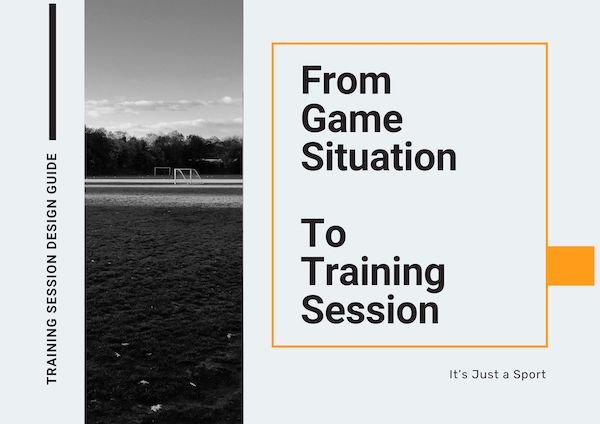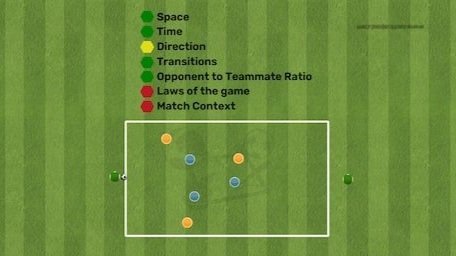Positional Play Training Series: 5v2 Rondo - Brighton's Third Man Combinations
In this article, we’re going to break down the 5v2 rondo.
But to make this even more practical, I’m going to show you how using game constraints we are going to logically build up the 5v2 rondo towards the kind of interactions we are seeing with De Zerbi's Brighton in the 22/23 season.
BRIGHTON’S THIRD MAN COMBINATIONS
First, let’s chat about Brighton.
This season (22/23) we have been seeing a pattern of third man combinations between the back line, midfield line, and front line when building-up. Third man combinations are not uncommon when building-up. They allow the team to advance up the field while minimizing the risk of losing possession and creating conditions to be able to defend if the ball is lost.
However, what’s unusual about Brighton’s third man combinations through the midfield is how close the players are between each other and how far away from the opposition’s goal they occur.
You can see the center backs keep the ball between each other in order to attract the opposition front line players, and when this happens they exploit the space as quickly as possible using third man combinations.
This all occurs in their own half because by doing so there is more space behind the opposition’s back line. Essentially, they don’t want the opposition to sit in a low block. Brighton want to draw them out.
This may look like a prescribed pattern of play because it happens so often and each instance of this occurring looks very similar. However, to be able to execute this to perfection players must understand each other’s intentions, as well the being able to understand and play off of the opponent’s movements.
In short, this type of build up requires high quality interactions and the only way to do it is training those interactions.
TRAINING CONSIDERATIONS
Before I jump into the practical section of this article, I would highly recommend you read Positional Play Training Series: Introduction to understand why Rondos and Positional Game are not sufficient to develop the kind of high quality interactions this requires.
To further understand the method that I am going to use to logically build up a rondo to game situation, read Positional Play Training Series: 3v1 Rondo.
the problem with RONDOs
We’re going to start with a 5v2 Rondo.
As you know, the problem with this type of rondo is it doesn’t progress. It is simply a possession game.
Like with everything else, this rondo has benefits and drawbacks. A potential drawback is it can condition players to make possession an objective in itself. I have accidentally done this with past teams I have coaches. They fail to recognize moments to progress the ball towards the opposition’s goal.
To fully understand the benefits we have to understand the idea of standardization and variability. To standardize something means that we are keeping something the same regardless of the situation or context.
What Rondos and Positional Games do is they standardize a player’s position (to a certain degree). They essentially limit where the player can move. By doing so, players have to make one less decision. One less decision means that they can focus their attention on the timing, direction, and speed at which they execute within the activity.
Position is standardized and timing, direction, and speed are the variables players have more control over.
Why would this be helpful?
We are simplifying the game by minimizing the number of variables players have to consider when playing. A 5v2 rondo is a simplified version of the game and is useful when the players need this because they are struggling with the current demands of the match.
Simplified versions of the game should be used as much as necessary but as little as possible.
However, the beauty of the rondos, including the 5v2 rondo, is that you can use them as the building blocks to arrive at a more realistic game situation for your players to experience.
And in our case, develop interactions necessary to build up through the center channel (Brighton).
BUILDING ON THE RONDO
In order to know how we have to build it up towards the game, we have to know what makes the game the game.
We will use the constraints that are present in the match to gauge how close we are to the match. These will be our tools to arrive as close to the game as possible.
The game constraints are a natural consequence of the laws of the game. For example, directionality is a consequence of having goals on either end of the pitch. Transitions from attack to defense and vice-versa are a consequence of there being two teams and only one ball. When the possession of the ball changes teams, both teams will transition into a new phase (attacking or defending) with a new objective (score or prevent a goal).
Often football is discussed in terms of Space and Time. Space is defined by the playing area and time is defined by the opponent. If there is no clearly defined playing area, there is infinite space. If there are no opponents, there is infinite time.
What’s most important in this is we know where we have to end up - the match.
The football constraints we’ll use to measure our game realism are:
Space - The closer it is to the amount of space they will have in a match, the more realistic.
Time - The closer it is to the amount of time they will have in a match, the more realistic.
Goals/Directionality - Direction means realistic.
Transitions - Each team has an objective/direction means realistic.
Opponent to Teammate Ratio - The closer this is to equality, the more realistic.
Laws of the Game - the less number of rules we’re disregarding, the more realistic.
I will add an additional consideration because we have to remember that the purpose of training is to prepare players to play the game as it will be played on matchday. This is true for 7 year olds or 27 year olds. The difference is that for 7 year olds we wouldn’t prepare a tactical plan to win saturday’s match but we do want them to have a general understanding of how the match will play out. This means providing more contextual information in training about the match.
Match Context - The closer it replicates a game plan or tactic, the more realistic.
PRACTICAL APPLICATION
We’re going to start with 5v2 rondo.
We start with the simplest version of this rondo. It’s a square with five attacking players and two defenders. The positions are standardized to have four attacking players on each side of the square and one attacking player in the middle of the square.
As you can see in the image below when referencing our football constraints, it’s missing a handful.
It’s disregarding all laws except law #2 (The ball), law #4 (The players’ equipment), and law #12 (Fouls and misconducts). I just want to make it clear that it would be impossible to satisfy all the laws of the game in a training environment but the closer we get to it the better.
It doesn’t have a clear direction which means that we’re missing the team invasion principles of progression and finalization.
As it is, it doesn’t have transitions because the defender doesn’t have any objective after recovering possession of the ball. We could very easily include that by either stating that the defender has to dribble out of the square or placing goals around the outside of the playing area that the defender can score into.
The opponent to teammate ratio favors the attacking team by having three more players which fails to satisfy that constraint.
The space that the game is played in could be realistic; it's about the same amount of space that they’d experience in a match with that number of players. By manipulating this space we could either make it easier or harder but we’d do intentionally depending on what the players need.
The time players have to execute is usually linked with the amount of space they have. In this case, it’s about the same that they’d have in the match. Again, as with space we can manipulate time to make it easier or harder, but we’d do this to meet the players’ needs.
Lastly, this rondo does not provide any match context.
To further build up this 5v2 Rondo to the game, we’re going to manipulate the teammate to opponent ratio. We’re going to add another blue player as well as making the two endline players neutrals to add some directionality. We’ll also make positions less standardized by allowing the three blue and orange in the square to be able to go anywhere.
At the moment, directionality is only a yellow because the teams can go in either direction. This does not follow the logic of the game. To add realism to this activity, we can get rid of the neutrals (one more orange and blue player) and the objective now is to get the ball into the end zone. To facilitate the game, defenders have to start behind the halfway line (starting positions).
Next we’re going to add a match context. We’ll do this by adding goals for teams to score into after they get in the endzone, we’ll add goalkeeper, and more players for both teams. To facilitate the interactions we’ll add one neutral player (green).
With this set-up, we are recreating a build-up phase with two center backs, the #6 (neutral), #8, #9, and #10 getting into the endzone to score in the small goals. The defending team is set up with the #9 and #10 as the front line, and behind them is the #6, #8, and center back. The orange team is always going towards the small goals and the blue team towards the big goal.
All of this creates more match context.
Lastly, we add outside backs for the attacking team and wingers for the defending team. We get rid of the endzones and incorporate more laws of the game like throw-ins. You could also determine the winner of the match on goals.
This is now infinitely closer to the match from where we started with our simple 5v2 rondo.
Within the journey we took in the game design process, each step added more opportunities to experience those interactions necessary to master the third man combinations we see Roberto De Zerbi’s Brighton use in their build up (22/23 season).
How you get there is up to you. Just remember the more simplified the game situation is, the more match context you are losing. Whatever you choose, just be aware of what you are sacrificing.
Remember, simplified versions of the game should be used as much as necessary but as little as possible.
We want to remain Faithful to Football.






